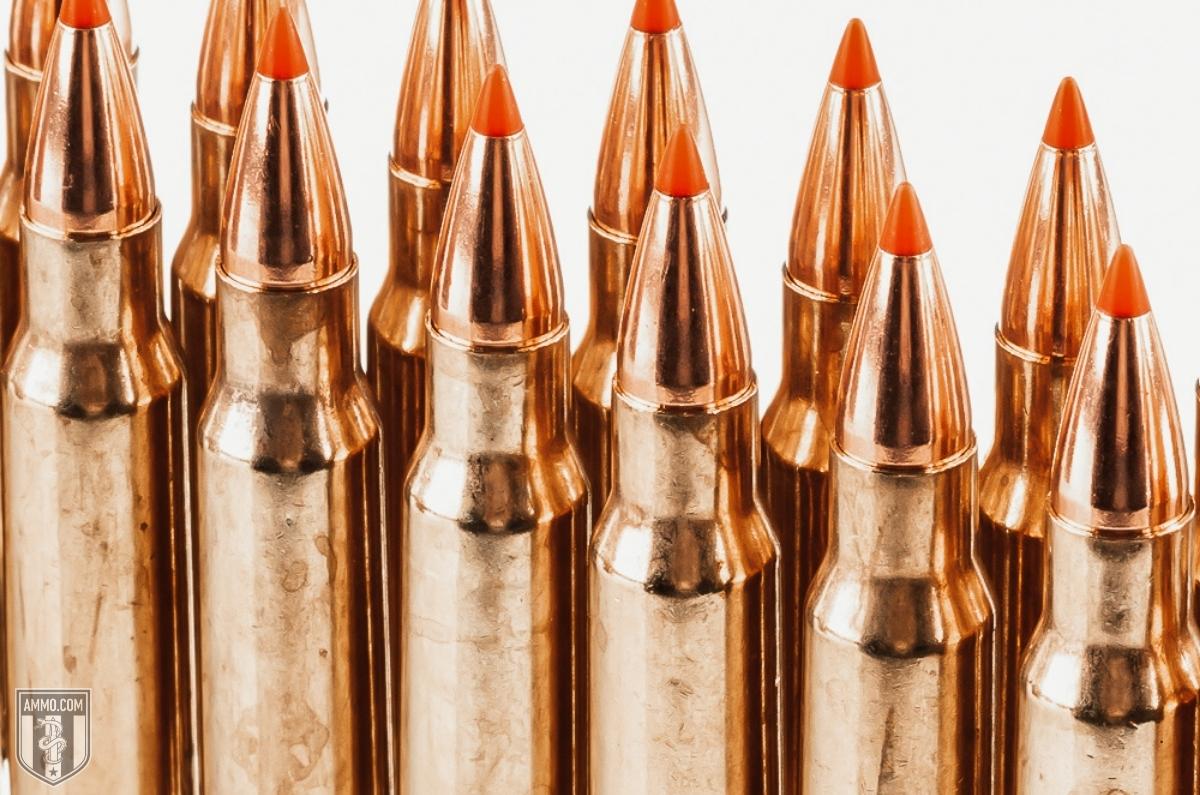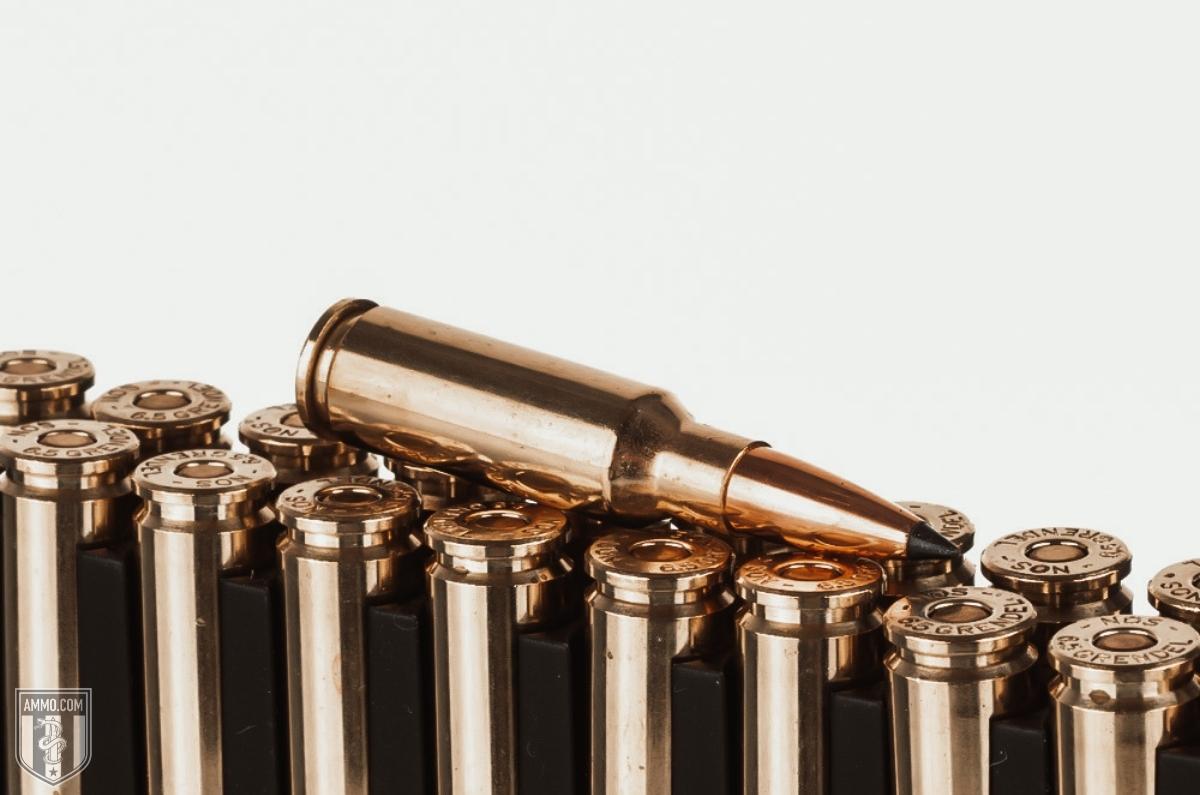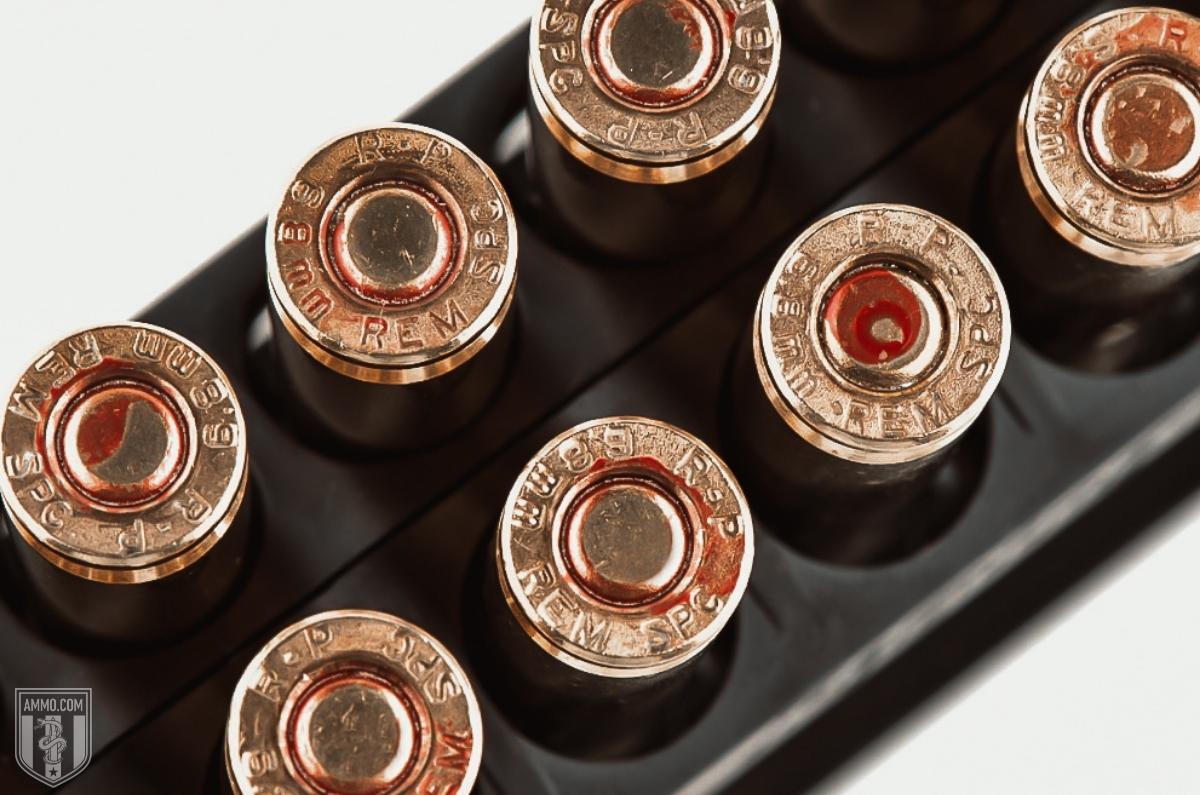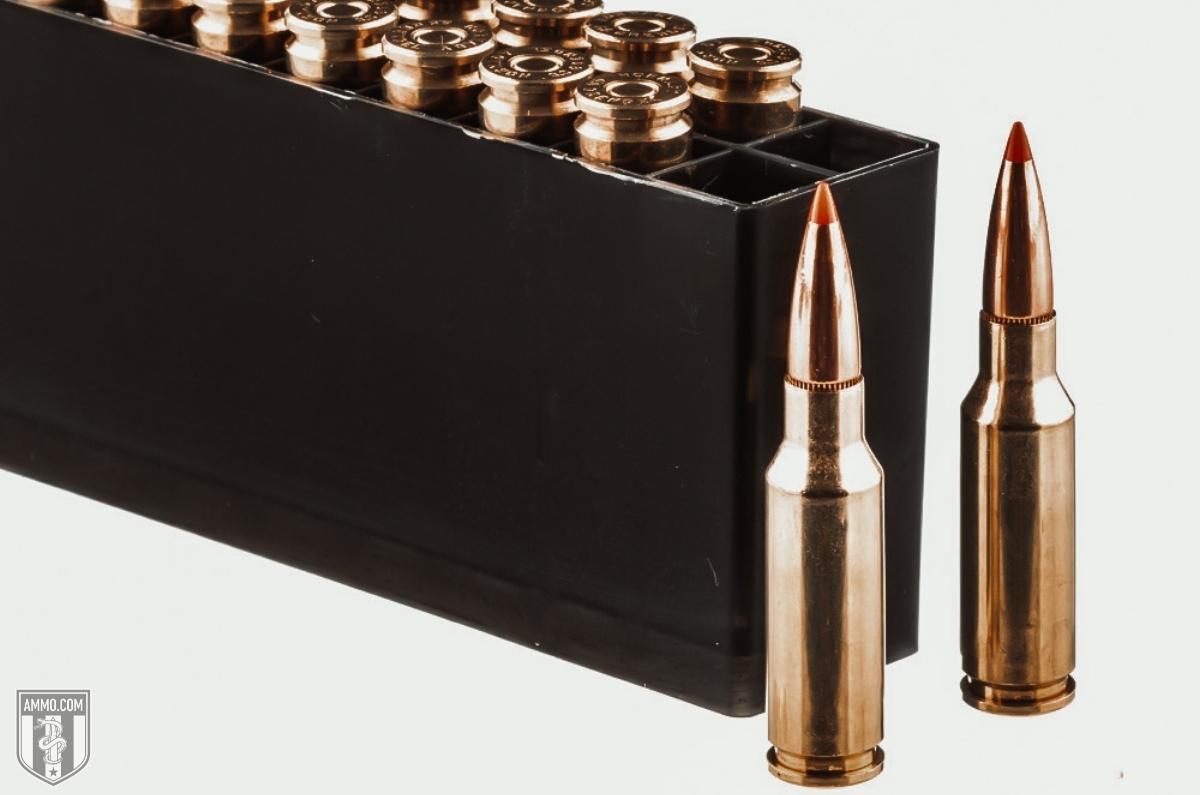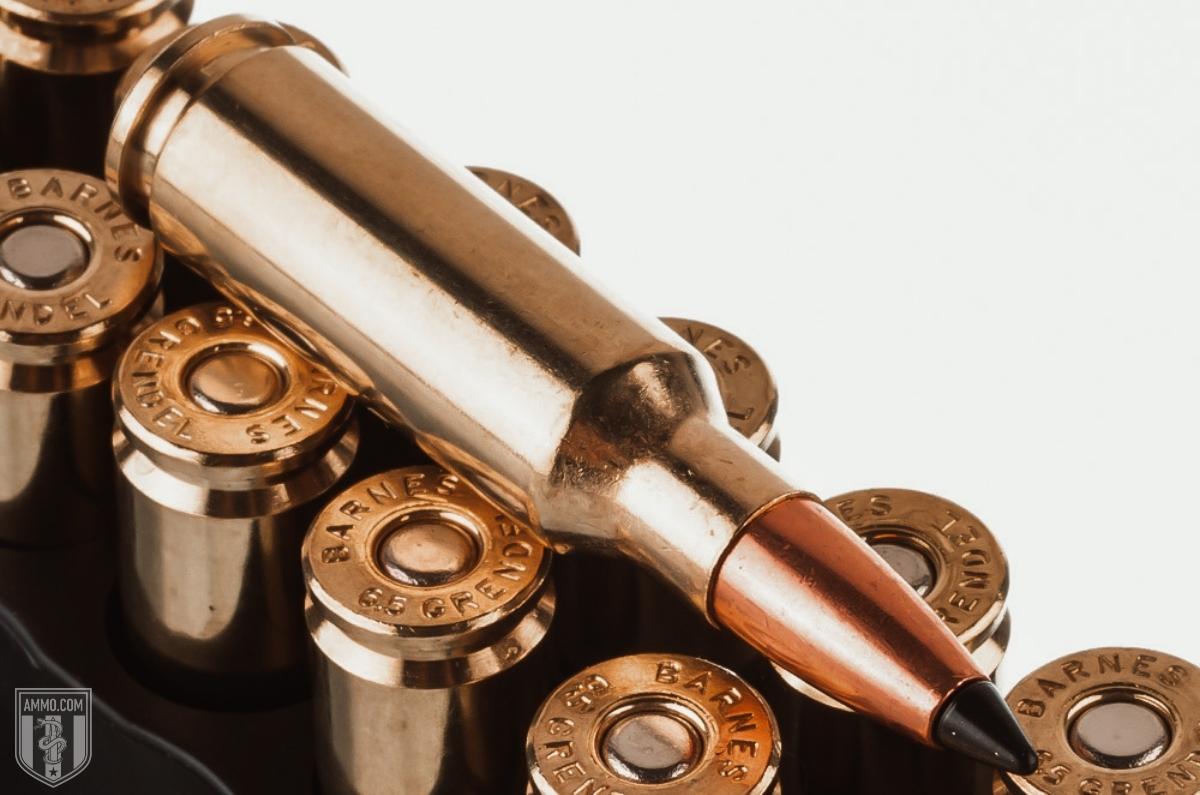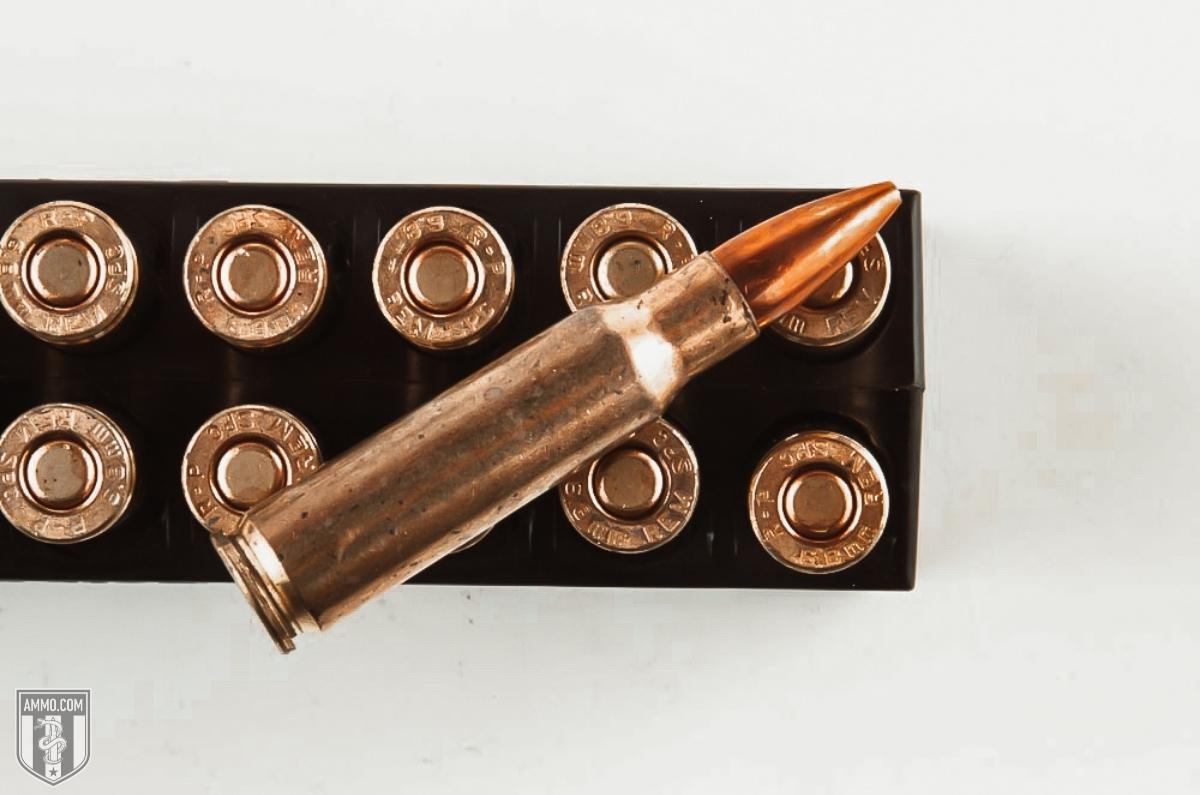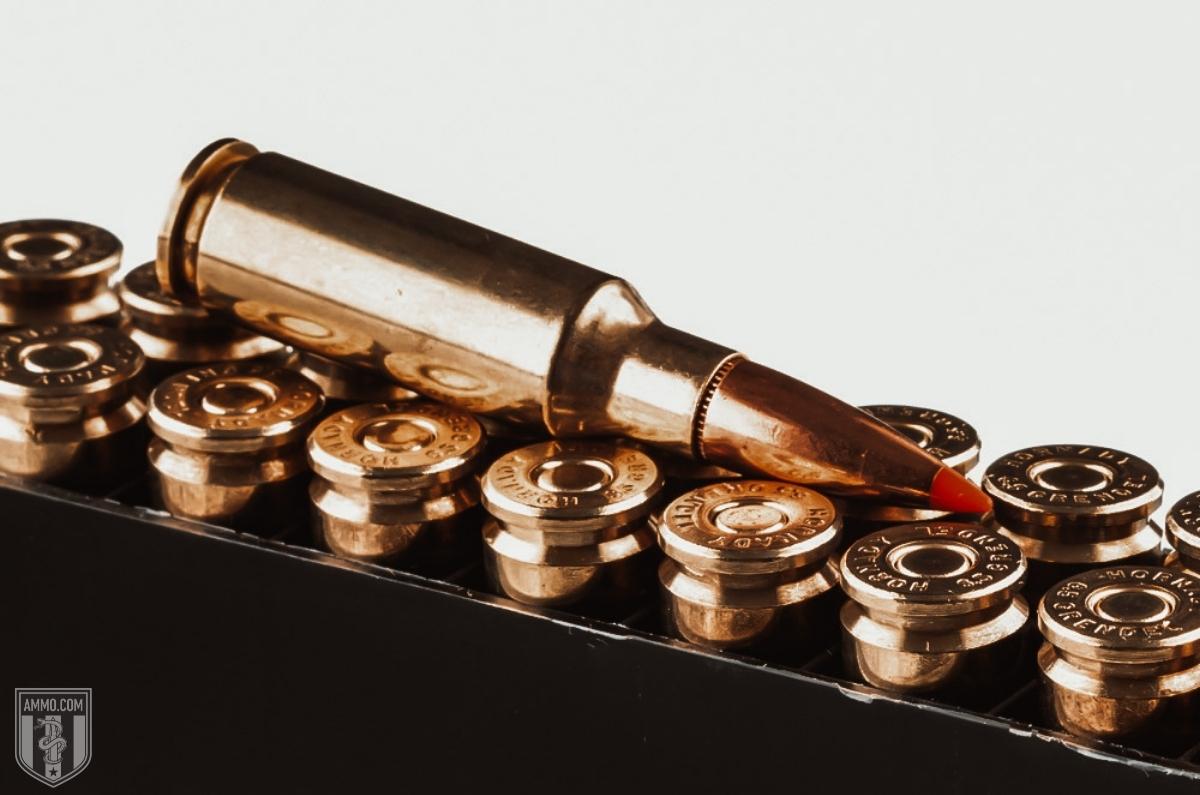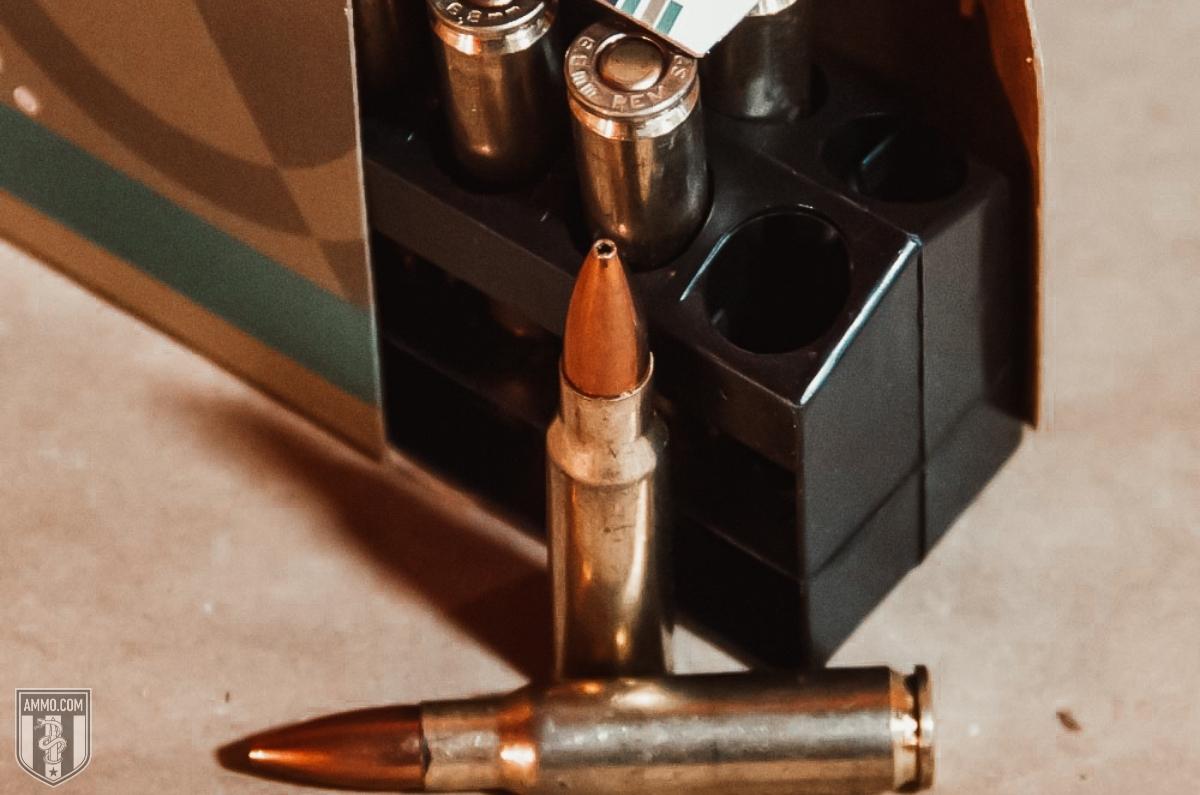6.8 SPC vs 6.5 Grendel: Enhancing The AR-15 Platform
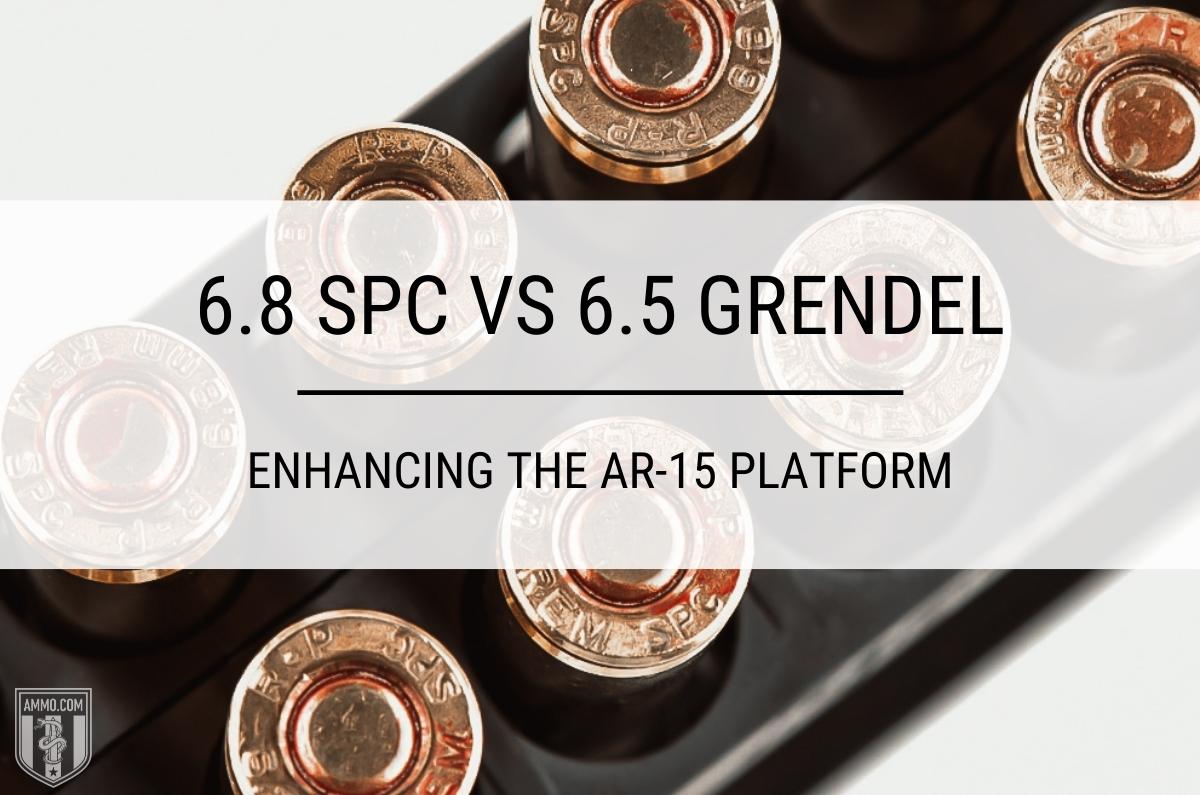 In the early 2000’s, there was a big push from the U.S. Army to adapt new, more powerful cartridges to the M4 carbine. This initiative was prompted by battlefield reports of enemy combatants taking multiple hits from 5.56 NATO rounds and remaining combat effective.
In the early 2000’s, there was a big push from the U.S. Army to adapt new, more powerful cartridges to the M4 carbine. This initiative was prompted by battlefield reports of enemy combatants taking multiple hits from 5.56 NATO rounds and remaining combat effective.
The 6.8 Remington Special Purpose Cartridge (SPC) and 6.5 Grendel were two new cartridges developed to increase the lethality of the AR-15 platform. Although their terminal ballistics were impressive, neither cartridge was adopted for mainstream military use.
The 6.8SPC and 6.5 Grendel may not have seen frontline combat, but they have enjoyed moderate commercial success from shooters who want a little more “oomph” out of their semi-automatic sporting rifles.
However, many 2A enthusiasts are perplexed over which cartridge to select for their new AR-15 if they want something other than the standard 5.56 NATO/223 Remington chambering. Is the 6.8 SPC better than 6.5 Grendel? Or does the 6.5 come out on top?
In this article, we will discuss the merits and shortcomings of the 6.8 SPC and 6.5 Grendel and how they can meet your shooting needs.
What is the difference between 6.8 SPC and 6.5 Grendel?
The main differences between the 6.8 SPC and 6.5 Grendel are the bullet diameters each cartridge fires and their intended purpose. The 6.8 SPC fires 0.277” diameter bullets compared to 0.264” for 6.5 Grendel. Furthermore, the 6.8 SPC was optimized for close quarters battle (CQB) conditions and to be employed in short barreled rifles (16” or less) whereas the 6.5 Grendel is at its best when fired from a 20 inch barrel at longer ranges.
Cartridge Specs
When evaluating centerfire rifle cartridges, it’s a good idea to analyze the cartridge specs to gain more knowledge of each.
The biggest difference between the 6.5 Grendel vs 6.8 SPC are the bullets they fire.
The 6.5 Grendel fires the sleek, aerodynamic 0.264” diameter bullets also fired by cartridges like the 6.5 Creedmoor, 260 Remington, and 6.5 PRC just to name a few. Grendel ammo is typically loaded with bullet weights ranging between 90-130 gr with the 100, 110, 120, and 123 gr offerings being the most popular.
On the other hand, the 6.8 SPC fired a wider 0.277” diameter bullet also utilized by cartridges like the 270 Winchester, 6.8 Western, and the new SIG 277 Fury. The 6.8 SPC typically fires bullet weights between 75-120 gr with the 85, 100, 110, 115, and 120 gr factory loads being the most common.
Both the 6.5 Grendel and 6.8 SPC have different base diameters of 0.439” and 0.422”, respectively. This means that both cartridges require a bolt change when performing a conversion on an AR-15.

The 6.8 SPC case is slightly longer, measuring 1.687”, than the 6.5 Grendel cartridge case, measuring 1.52”. Both cartridges have the same overall length of 2.26” as this is the maximum allowable cartridge length for the AR-15 platform. The longer case length for the SPC round means that more of the bullet must be seated inside the case to meet the overall length requirement. This, in turn, robs the cartridge of some case capacity and ballistic performance. On the other hand, the design of the 6.5 Grendel case allows for longer, high ballistic coefficient bullets to be utilized without having to seat them deep inside the case. This is a similar tactic that the ballisticians at Hornady used when developing the 300 PRC.
Even though the 6.8 SPC has a longer case, it has virtually the same case capacity as the 6.5 Grendel at 35 gr. However, the 6.8 SPC is rated to handle slightly higher chamber pressures of 55,000 psi vs 52,000 psi for the Grendel per SAAMI specs.
Recoil
The 6.8 SPC will generally have slightly less recoil than the 6.5 Grendel.
Recoil is an important consideration when purchasing a new rifle as a round with heavy recoil will be more difficult to control and will slow your rate of follow up shots.
Recoil is affected primarily by muzzle velocity (FPS), powder charge, bullet weight, and rifle weight.
The 6.5 Grendel will typically have slightly more free recoil energy than the 6.8 SPC as the Grendel can handle slightly more powder (since the bullets aren’t seated as deep) and are fired at higher muzzle velocities.
For example, a 6.5 Grendel 123 gr Hornady SST fired from a 6-pound AR-15 at 2,500 fps will have a free recoil energy of around 11 ft-lbs compared to 9 ft-lbs for a 6.8 SPC 120 gr SST fired at 2,400 fps from the same rifle.
It should be noted that both cartridges are considered low recoil and shooters can enjoy a full day at the range shooting both without any adverse shoulder-bruising effects. However, for recoil sensitive shooters, the 6.8 SPC is typically the better option.
Muzzle Velocity and Kinetic Energy
Generally, the 6.5 Grendel will have higher muzzle energy and muzzle velocity than the 6.8 SPC.
As the 6.5 Grendel was designed for long range target shooting, it requires better ballistics to reach its intended target. However, manufacturer’s ballistic data can sometimes be misleading due to differences in barrel length.
Take for example the 123 gr SST Hornady factory load for 6.5 Grendel and 120 SST for 6.8 SPC. Hornady states that the 123 gr 6.5 Grendel round will have a muzzle velocity of 2,580 fps and muzzle energy of 1,818 ft-lbs when fired from a 24” barrel. On the other hand, the 6.8 SPC 120 gr SST is reported as having a muzzle velocity of 2,460 fps and energy of 1,612 ft-lbs from a 16” barrel.
The difference in barrel length is quite significant and showcases one of the major differences between these two cartridges. The 6.8 SPC was specifically designed for use in the M4 carbine, which has a 14.5” barrel length, while Alexander Arms (the developer of the 6.5 Grendel) recommends using a barrel of no less than 20” for its cartridge.
Those familiar with long-range shooting know that a long barrel is preferred to a short one as bullets fired from a shorter barrel typically have a lower muzzle velocity. Although the 6.8 SPC can reach its peak performance in a short barrel, the 6.5 Grendel needs the extra barrel length to reach its full potential.
If you were to fire a 6.5 Grendel form a 16 inch barrel, most of its ballistic advantage over the 6.8 SPC is erased and both cartridges would have similar muzzle velocities and muzzle energies.
Trajectory
When fired from a longer barrel, the 6.5 Grendel has a flatter trajectory at all ranges compared to the 6.8 SPC.
Trajectory is how we quantify a bullet’s flight path as it travels downrange measured in inches of bullet drop.
Obviously, a flatter shooting cartridge is preferred for long-range shooting, as a shooter will require fewer adjustments to their optics to compensate for bullet drop. Having a flatter trajectory also means that a cartridge will be more forgiving of ranging mistakes.
At shorter ranges under 200 yards, both cartridges have virtually identical trajectories. However, with its higher muzzle velocity and higher ballistic coefficient bullets, the 6.5 Grendel simply dominates the 6.8 SPC at longer ranges. Assuming a 100 yard zero for both cartridges, at 500 yards the 6.5 Grendel has experienced -64” of bullet drop compared to -79” for the 6.8 SPC.
Ballistic Coefficient
The 6.5 Grendel generally will have a higher ballistic coefficient as it was designed to fire longer, more aerodynamic bullets.
Ballistic coefficient (BC) is a measure of how well a bullet resists wind drift and air resistance. Put another way, it’s a numeric representation of how aerodynamic a bullet is. A high BC is preferred as this means the bullet will buck the wind easier.
Generally, heavy bullets will have a higher BC as it takes more force to disrupt the flight of a heavier bullet than a lighter one. Ballistic coefficient varies from bullet to bullet based on design, weight, and other factors that are beyond the scope of this article.
The ability of 6.5mm bullets to resist wind drift is well documented with the rise in popularity of the 6.5 Creedmoor. As the 6.5 Grendel can fire the same sleek bullets as the Creedmoor, it is not surprising that the 6.5 Grendel will outperform the 6.8 SPC in terms of BC.
Take for example the Barnes Tipped TSX bullets, which are extremely popular with big game hunters. The 120 gr 6.5 Grendel TSX bullet has a BC of 0.412 compared to 0.377 for the 110 gr 6.8 SPC TSX bullet.
Sectional Density
The 6.5 Grendel will typically have a higher sectional density and penetrate deeper than the 6.8 SPC.
Sectional Density (SD) is the measure of how well a bullet penetrates a target. This is extremely important when hunting big and medium sized game, as you need a bullet that can punch through thick hide, bone, and sinew.
Sectional density is calculated by comparing the bullet weight and the bullet diameter. The higher the SD the deeper the bullet will penetrate into the target. This is a simplified view of penetration as there are other factors to consider, such as bullet expansion and high velocity.
As the 6.5 utilizes a longer bullet design, it is able to focus its higher muzzle energy onto a smaller area and thereby increasing its penetration.
For example, the 100 gr Nosler Ballistic Tip bullet for 6.5 Grendel has a SD of 0.205 while a 100 gr Nosler AccuBond for 6.8 SPC has a SD of 0.186.
Although the 6.5 Grendel does generally have a higher sectional density than the 6.8 SPC, the difference is so minor that it is unlikely any hunter, whitetail, or feral hogs will be able to tell the difference.
Hunting
Although the 6.5 Grendel and 6.8 SPC have not been issued to GI’s on the front lines, hunters have discovered the power and flexibility each have as a hunting cartridge.
Internet forums are always ablaze in debates over which is better for whitetail, hogs, and varmints. When it comes to 6.5 Grendel and 6.8 SPC, both cartridges are exceptional at deer hunting while the 6.5 Grendel is more suited for varmints and the 6.8 SPC has made a name for itself in hog hunting circles.
With its long range capabilities and flat trajectory, the 6.5 Grendel is an excellent choice for varmint hunting. With its longer effective range of over 1,000 yards and better ballistic performance, the 6.5 really excels at dispatching thin skinned varmints and longer ranges. This is not to say that the 6.8 cannot be used on varmints, but the superior ballistic coefficient of Grendel ammo really makes it an attractive choice for long-range shooting.
For whitetail and mule deer, both the 6.5 and the 6.8 are exceptional choices at typical hunting ranges. The 6.8 SPC has an effective range of around 200 yards for deer hunting while the 6.5 Grendel can harvest deer out to 400 yards. However, the 6.8 SPC gets the nod here as its terminal performance on game animals is slightly better than the 6.5 and the 6.8 can achieve these results when fired from a shorter barrel. When sitting in a tree stand or maneuvering through thick brush on a stalk, a lighter and more compact rifle is easier to handle. As the 6.8 SPC is optimized for hunting with a 16 inch barrel, it is the better choice when hunting in heavily wooded areas like those encountered in the Midwest or Pacific Northwest. However, if longer shots need to be taken like those on the Great Plains and barrel length is less of an issue, then the 6.5 Grendel would be a better choice.
For hog hunting in the southern states, the 6.8 SPC has quite the reputation as a potent porcine slaying round. As improved terminal performance is preferred on larger animals, the 6.8 finds itself in a great position when facing down a herd of unruly hogs intent on destroying a farmer’s field in a night. With its lower recoil impulse, the 6.8 SPC allows for faster follow-up shots or multiple target engagements more effectively than the 6.5 Grendel. Furthermore, the 6.5’s longer effective range is less important when hog hunting, as most shots are within 250 yards or less. For hogs, it’s clear that the 6.8 SPC is the better choice.
Ammo and Rifle Cost/Availability
As far as ammo availability is concerned, both the 6.8 SPC and 6.5 Grendel are about the same. Most of your major ammo manufacturers like Remington, S&B, Federal, Nosler, and Barnes have factory ammo for both cartridges.
In terms of cost, inexpensive FMJ ammo will be slightly less expensive for the 6.8 SPC at around $1.40/round compared to $1.70/round for 6.5 Grendel. For premium hunting ammo, both cartridges are essentially equivalent starting close to $2/round and going up from there.
In terms of rifles, the 6.5 Grendel has a slight edge over the 6.8 SPC in terms of varieties and numbers.
Premium AR-15 manufacturers like Wilson Combat, LWRC, Savage, and Barrett have offerings in both 6.5 and 6.8, with dedicated rifles and upper receivers.
If you want a bolt gun, the 6.5 Grendel is your only option as the 6.8 SPC is limited to the AR-15 only at the time of writing. The Ruger American Ranch and Predator, Howa Mini, and CZ 527 are currently the only bolt action rifles available in 6.5 Grendel.
Reloading
Reloading is one way that shooters can decrease their overall cost per round for both cartridges.
Brass, reloading dies, primers, and powders are readily available for each. However, when it comes to bullet selection the 6.5 has a slight edge due to the proliferation and popularity of the 6.5 Creedmoor. As the Grendel and Creedmoor fire the same bullet diameter, 6.5 Grendel shooters will enjoy a wider array of bullet options and weights than 6.8 shooters.
However, as the U.S. Army recently adopted the 277 SIG Fury as their new battle cartridge, the future looks bright for fans of the 6.8 caliber bullet.
Handloaders also have the opportunity to explore the full capability of the 6.8 SPC, as most factory ammo is not loaded to full power due to chamber design flaws experienced with the failed rollout of the first iteration of the 6.8.
6.8 SPC vs 6.5 Grendel Ballistics
Our team here at Ammo.com has spent countless hours scouring the Internet to bring you extremely comprehensive ballistics tables for both calibers. Below are tables that compare bullet weight to muzzle velocity, kinetic energy, and trajectory for both 6.5 Grendel vs 6.8 SPC.
6.5 Grendel Ballistics
Note: This information comes from the manufacturer and is for informational purposes only. The actual ballistics obtained with your firearm can vary considerably from the advertised ballistics. Also, ballistics can vary from lot to lot with the same brand and type load.
| 6.5mm Grendel Bullet WEIGHT | Muzzle VELOCITY (fps) | Muzzle ENERGY (ft. lbs.) | TRAJECTORY (in.) | |||||||||||
|---|---|---|---|---|---|---|---|---|---|---|---|---|---|---|
| Muzzle | 100 yds. | 200 yds. | 300 yds. | 400 yds. | Muzzle | 100 yds. | 200 yds. | 300 yds. | 400 yds. | 100 yds. | 200 yds. | 300 yds. | 400 yds. | |
| 123 Grain | 2590 | 2420 | 2256 | 2099 | 1948 | 1832 | 1599 | 1390 | 1203 | 1037 | 1.8 | 0 | -8.6 | -25.1 |
6.8 SPC Ballistics
Note: This information comes from the manufacturer and is for informational purposes only. The actual ballistics obtained with your firearm can vary considerably from the advertised ballistics. Also, ballistics can vary from lot to lot with the same brand and type load.
| 6.8 SPC Bullet WEIGHT | Muzzle VELOCITY (fps) | Muzzle ENERGY (ft. lbs.) | TRAJECTORY (in.) | |||||||||||
|---|---|---|---|---|---|---|---|---|---|---|---|---|---|---|
| Muzzle | 100 yds. | 200 yds. | 300 yds. | 400 yds. | Muzzle | 100 yds. | 200 yds. | 300 yds. | 400 yds. | 100 yds. | 200 yds. | 300 yds. | 400 yds. | |
| 90 Grain | 2840 | 2444 | 2083 | 1756 | 1469 | 1611 | 1194 | 867 | 616 | 431 | 2.2 | 0 | -3.9 | -32 |
| 110 Grain | 2570 | 2338 | 2118 | 1910 | 1716 | 1613 | 1335 | 1095 | 891 | 719 | 2.4 | 0 | -6.3 | -20.8 |
| 115 Grain | 2775 | 2472 | 2190 | 1926 | 1683 | 1966 | 1561 | 1224 | 947 | 723 | 2.1 | 0 | -3.7 | -9.4 |
| 120 Grain | 2460 | 2250 | 2051 | 1863 | 1687 | 1612 | 1349 | 1121 | 925 | 758 | 2.3 | 0 | -10.5 | -31.1 |
A Brief History of 6.5 Grendel
Ever since the adoption of the 223 Remington/5.56 NATO cartridge by the US armed forces, critics have questioned the combat effectiveness and terminal ballistics of the 22-caliber round. As a result, several intermediate cartridges have been adapted to the AR-15 platform such as the 300 Blackout and 6.8 SPC in an attempt to bridge the gap between the 223 Reminton and 308 Winchester.
Never one to back down from a challenge, British/American armorer Bill Alexander of Alexander Arms debuted the 6.5 Grendel in May 2003 at the Blackwater training facility in North Carolina. Alexander Arms also utilized the services of competitive shooter Arne Brennan and senior ballistician Janne Pohjoispää of Lapua in development of the new rifle cartridge.
Bill Alexander was clearly a fan of mythology, as Grendel is the name of a monster in the British epic poem, Beowulf. Staying true to form, Alexander Arms also developed the 50 Beowulf cartridge for the AR-15 as well.
The goal of the 6.5 Grendel was to develop an intermediate cartridge that extended the effective range of AR-15 rifles out past 800 yards. Utilizing the same higher ballistic coefficient 0.264” diameter bullets used by the 6.5 Creedmoor, the 6.5 Grendel is capable or maintaining MOA-level accuracy and supersonic velocities out to 1,200 yards with half the recoil of the 308 Win.
Descended from the 6.5mm PPC, which itself was developed from the 220 Russian and 7.62x39mm, the 6.5 Grendel has a wider case head than the 223 Remington and requires a non-standard AR-15 bolt and specialized magazines for use in AR-15 rifles.
Wide-spread adoption of the 6.5 Grendel was somewhat hindered by Bill Alexander himself, as he insisted that the cartridge be trademarked, and therefore could not be standardized by SAAMI. However, Alexander Arms in collaboration with Hornady Ammunition, registered the 6.5 Grendel with SAAMI in 2010. This allowed other manufacturers to create and sell 6.5 Grendel ammo, greatly expanding the reach of the cartridge.
As the 6.5 Grendel is still a relatively new cartridge on the market, it has developed a stalwart following in the shooting community who enjoy the terminal ballistics of a 308 Win without having to upgrade to an AR-10.
Although the 6.5 Grendel has not yet been adopted by the US military, the Serbian military is currently conducting tests in accordance with adopting the 6.5 Grendel in their new M17 Zastava battle rifles.
With exceptional long range capability, barrel life, and MOA-level accuracy, the 6.5 Grendel is an excellent choice if you’re looking to upgrade your AR-15 platform to something that has a bit more stopping power than a 223 Rem.
To read more about the 6.5 Grendel, check out the full history on our 6.5 Grendel history page.
If you’d like to learn more about how the 6.5 Grendel compares to other calibers, check out these articles below:
- 6.5 Grendel vs 308
- 6.5 Grendel vs 223 vs 5.56
A Brief History of 6.8 SPC
The 6.8 Remington Special Purpose Cartridge (6.8 SPC, 6.8 SPC II, or 6.8x43mm) was developed in 2004 as a joint operation between Remington Arms, US Special Operations Command (USCOCOM), and the U.S. Army Marksmanship unit.
The goal of the cartridge was to increase the terminal performance of the M4 carbine, as urban close quarters battle (CQB) in the 2nd Iraq War had showcased some deficiencies in the 5.56x45mm NATO/223 Remington cartridge.
Initial designs for the 6.8 SPC came from Master Sgt. Steve Holland and Chris Murray, who used the 30 Remington as a parent case that was modified to fit in standard M4 magazines.
One key design point was that the 6.8 SPC was developed to perform better in short-barreled rifles (SBR) like the M4 carbine, as opposed to the longer M16 assault rifle.
Fired from an M4, the 6.8 SPC can deliver almost 45% more kinetic energy into its target than standard 62 gr M855 NATO ammunition.
Although the 6.8 SPC seemed to be a potent answer to the 5.56 NATO terminal performance issue, there were some problems with its implementation.
Sadly, the chamber designs on the original 6.8 SPC cartridge were somewhat inaccurate, and the biggest issue was the free bore space at the mouth of the chamber.
The original chamber designs called for 0.050” of free bore, but combined with a 1:10 twist rate barrel, pressure issues began to creep up. Initial reports claimed that the rounds were only around 200 psi above the maximum 55,000 psi pressure limits, but if the military learned anything from Vietnam, it was to follow specs to the letter.
Remington sought to remedy the issue the best way they saw fit, which was to underload the ammo. As no one wants to shoot rounds that don’t live up to their full potential, the order was given for “Taps” to be played and the 6.8 SPC project was not adopted by the U.S. military.
However, in all the excitement over the new 6.8 SPC, several civilian firearm manufactures clambered to release rifles chambered in the new hotshot round before SAAMI had officially adopted the cartridge. With numerous faulty rifles in the wild, the only action SAAMI could take was to sanction the round.
This is not to say that original 6.8 SPC rifles won’t function properly, but there is the potential for a critical pressure failure when using full power rounds.
The answer was the 6.8 SPC II.
The 6.8 SPC II added an additional 0.050” of free bore to the chamber and decreased the barrel twist rate to 1:11. This completely solved the pressure issues experienced with the original design. All current rifles chambered in 6.8 SPC are actually chambered in 6.8 SPC II.
The 6.8 SPC II offers hunters an excellent intermediate cartridge option for small to medium game, while handloaders love the cartridge for its versatility. Capable of firing 85-140 grain bullets, the 6.8 SPC II allows reloaders the ability to load their ammo light for plinking and hot for hunting.
Although most factory loads will be loaded light (due to original 6.8 SPC rifles still in the wild), the 6.8 SPC II sits in the sweet spot between the ubiquitous 0.308” and diminutive 0.224” calibers. This offers shooters the power they need for medium game hunting without the increased recoil and heavier firearm (AR-10) associated with the 0.308.
To read more about the 6.8 Remington SPC, check out the full history of the cartridge on our 6.8 SPC history page.
Final Shots: 6.5 Grendel vs 6.8 SPC
The 6.5 Grendel and 6.8 SPC are two intermediate cartridges developed to increase the lethality of the AR-15 platform. Both cartridges achieved this goal and have better ballistics than the anemic 5.56 NATO.
Adapting new cartridges to the AR-15 is nothing new, as other offerings like the 224 Valkyrie and 300 Blackout also look to enhance the breadth and depth of ammo options for the most popular sporting rifle in the world.
The 6.5 Grendel is a great option for long range target shooting and an extremely capable hunting cartridge. Its sleek 6.5mm bullets have incredibly high ballistic coefficients and sectional densities that make the Grendel round a potent long-range shooting threat. The one limiting factor to the 6.5 Grendel is its reliance on a longer barrel length of 20 inches or more to achieve its full potential.
The 6.8 Remington Special Purpose Cartridge focuses more on terminal performance in a short barreled rifle (SBR) over long range performance. Optimized for the M4 carbine with a 16 inch barrel or less, the 6.8 SPC offers shooters a powerful cartridge that has 40% more kinetic energy than the 5.56 NATO within 300 yards in a tight, lightweight package. However, the 6.8 is less effective at longer ranges as it hemorrhages energy and velocity as distances over 500 yards.
Selecting the right cartridge for your needs primarily centers on what ranges you expect to shoot at. For typical hunting ranges of 300 yards or less, the 6.8 SPC has a lot to offer with lower recoil and better terminal ballistics in a shorter rifle. However, if you expect to shoot over 300 yards and don’t mind using a longer barrel length, then the 6.5 Grendel offers you a cartridge that can extend your effective range out past 500 yards.
Regardless of which cartridge you choose, make sure you stock up on ammunition here at Ammo.com and I’ll see you on the range!
Ammo Comparisons
- .308 vs 5.56
- 6.5 Creedmoor vs .308
- .300 Blackout vs .308
- .300 Win Mag vs .308
- .243 vs .308
- .308 vs .30-06
- 7mm-08 vs .308
- .270 vs .308
- 7.62x39 vs .308
- .223 vs .308
- .338 Lapua vs .308
- .380 ACP vs 9mm
- .223 vs 5.56
- .300 Blackout vs 5.56
- 9mm vs 45 ACP
- 9mm vs 40 S&W
- .357 SIG vs 9mm
- 10mm vs 9mm
- 9mm vs 9mm Luger
- .243 vs .270
- .300 Win Mag vs .30-06
- .270 vs .30-06
- .40 vs .45
- 38 Special vs 357
- 9mm vs 40 vs 45
- 5.56 vs 7.62x39
- 338 Lapua vs .30-06
- .30-30 vs .30-06
- 300 PRC vs 338 Lapua
- .30-06 vs 7mm
- 300 Win Mag vs 338 Lapua
- 300 PRC vs 300 Win Mag
- 300 WSM vs 300 Win Mag
- 338 Win Mag vs 338 Lapua
- 12 Gauge vs 20 Gauge
- 10mm vs 357 Mag
- .30-30 vs 7.62x39
- 224 Valkyrie vs 22-250
- 17 HMR vs 22 Mag
- 7.62x39 vs .300 Blackout
- 45 ACP vs 45 Auto
- 45-70 vs 30-30
- 300 Blackout vs 223
- 357 Magnum vs 9mm
- 350 Legend vs 300 Blackout
- 224 Valkyrie vs 223
- 45 ACP vs 38 Super
- 6.5 Grendel vs .308
- 17 HMR vs 22 LR
- 10 Gauge vs 12 Gauge
- 22-250 vs 223
- 45 Colt vs 45 ACP
- 350 Legend vs 30-30
- 5.7x28 vs 223
- 5.7 vs 9mm
- 5.56 vs 5.7
- 22 vs 9mm
- Buckshot vs Birdshot
- 450 Bushmaster vs 308
- 450 Bushmaster vs 223
- Buckshot vs Slug
- 6.5 Grendel vs 5.56 vs 223
- 6mm ARC vs 6.5 Grendel
- 44 vs 45
- 458 SOCOM vs 5.56
- 357 vs 44
- 32 ACP vs 380
- 300 Win Mag vs 338 Win Mag vs 338 Lapua Mag
- 450 Bushmaster vs 458 SOCOM vs 50 Beowulf
- 6mm Creedmoor vs 6.5 Creedmoor
- TMJ vs FMJ
- 44 Special Vs 44 Magnum
- 45 90 vs 45 70
- 6.8 Western vs 6.8 SPC
- 50 Beowulf vs 50 BMG
- 26 Nosler vs 6.5 PRC
- 28 Gauge vs 410
- 6.8 SPC vs 5.56
- 6.8 SPC vs 6.5 Grendel
- 6.8 Western vs 7mm Rem Mag vs .28 Nosler
- 6.8 Western vs 6.5 Creedmoor
- 22 Hornet vs 223
- 6.8 Western vs 6.5 PRC
- .410 vs 12 Gauge
- .410 vs 20 Gauge
- 22 LR vs 22 Mag
- 6mm ARC vs 243
- 7mm-08 vs 270
- 243 vs 6.5 Creedmoor
- Nickel vs Brass Casing
- 204 Ruger vs 223
- 50 Beowulf vs 5.56
- 260 Remington vs 6.5 Creedmoor
- 6mm Remington vs 243
- 28 Nosler vs 300 PRC
- 50 Beowulf vs 50 AE
- 22 Nosler vs 22-250
- 450 Marlin vs 45-70
- 300 Win Mag vs 300 Norma
- 458 SOCOM vs 300 Blackout
- 38-55 vs 45-70
- 22 Hornet vs 22 LR
- 300 Norma vs 338 Lapua
- 338 Lapua vs 50 BMG
- 28 Nosler vs 300 Win Mag
- 28 Nosler vs 6.5 Creedmoor
- 204 vs 22-250
- 458 SOCOM vs 45 70
- 44 40 vs 45 70
- 6.8 SPC vs 6.5 Creedmoor
- 450 Bushmaster vs 30-06
- 7mm Rem Mag vs 300 Win Mag
- 30 Carbine vs 223
- 25-06 vs 30-06
- 26 Nosler vs 28 Nosler
- 16ga vs 12ga
- 30 06 vs 7.62 x54R
- 9mm Makarov vs 9mm Luger
- 350 Legend vs 223
- 30 Carbine vs 5.56
- 6.5x55 vs 6.5 Creedmoor
- 6.5 Creedmoor vs 270 vs 25-06
- M193 vs M855
- 450 Bushmaster vs 458 SOCOM
- 6.5 Grendel vs 6.5 Creedmoor
- 350 Legend vs 5.56
- .277 Fury vs 6.8 SPC
- 277 Fury vs 300 Win Mag
- 10mm vs .45 ACP
- 277 Fury vs 223
- 6.8 SPC vs 300 Blackout
- 6.5 PRC vs 6.5 Creedmoor
- 277 Fury vs 308
- 277 Fury vs 6.5 Creedmoor
- 350 Legend vs 450 Bushmaster
- 277 Fury Vs 5.56 NATO
- 10mm vs 40S&W
- 32 ACP vs 9mm
- 32 Special vs 9mm
- 8.6 Blackout vs 300 Blackout
- 30 Super Carry vs. 9mm
- 5.56 vs 9mm
- .50 Action Express vs 9mm
- 7.62x25 vs. 9mm
- 10mm vs 44 Magnum
- 300 Blackout vs 300 Win Mag
- 6.5 Grendel vs 300 Blackout
- 460 Rowland vs 10mm
- 300 RUM vs 300 PRC
- 300 Norma vs 300 PRC
- 45 GAP vs 45 ACP
- 7mm PRC vs 300 Win Mag
- 300 PRC vs 6.5 Creedmoor
- 300 PRC vs 308
- 357 SIG vs 357 Mag
- 7.62x39 vs 7.62x51
- 243 Win vs 223 Rem
- 30 Nosler vs 300 PRC
- 6.5 Creedmoor vs. 30-06 Springfield
- 450 S&W vs. 44 Magnum
- 6.5 Creedmoor vs. 300 Win Mag
- 454 Cassull vs. 45-70 Govt
- 454 Cassull vs. 44 Mag
- 7.62x54r vs. 308 Winchester
- 22 ARC vs. 223 Rem
- Subsonic vs. Supersonic Ammo
